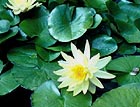Planting on waterlogged land
Mark Griffiths finds that landscaping around flood-prone land can be a wonderful way of protecting the houses in the area


Do you remember Biloxi? The Missi-ssippi city was uprooted by Hurricane Katrina in 2005, and now it is undergoing a 10-year restoration programme. This is restoration with a difference: not only will housing not be rebuilt in some of the worst-affected areas, but numerous dwellings that survived the disaster will be demolished. In their place, the plan is to reinstate the patchwork of cypress swamp and coastal savannah that once formed a natural barrier between the city and the elements.The State of Mississippi concludes that wilderness is the best protection against Nature's savagery.
If only our own masters were similarly wise after the event. Oxford always was prone to flooding and the human response used to be to husband its environs accordingly. The result is a landscape of reed-bed, water meadow and willow-fringed ditch that looks more like the paintings of Corot than crisis management. It submerges and emerges; it breathes and drains; it works. And yet, despite this summer's floods, we are told that thousands of homes must be built there. On stilts, one trusts. Not everywhere is up for grabs, however. Following the last deluge, I had a call from a friend who wants to plant his periodically waterlogged land, not build on it. On its wilder fringes grow the willows, alders, poplars and dogwoods that characterise Oxford's threatened wetland. Now he seeks something more exotic for the cultivated but sometimes sodden area of neutral to acid soil nearer the house.
Eastern North America is astonishingly rich in hardy trees and shrubs that'll grow with their feet in water for part of the year at least. One of the best is sweet or swamp bay, Magnolia virginiana, a small, multi-stemmed, and usually semi-evergreen tree found from Massachusetts to Mississippi. Although this was possibly the first magnolia to be introduced to English gardens back in the 17th century, we soon forsook it, but M. virginiana is making a return, and especially new selections of it such as Moonglow and Satellite. Both are elegant cultivars with pewter trunks and columnar crowns. Glossy above and silvery beneath, their neat, laurel-like leaves should prove evergreen in our present run of mild winters, but fear not if they do drop; new ones will emerge. The ivory flowers, waxy-textured, perfectly cupped and scented of lemon sorbet, appear in one major flush in early summer and sporadically thereafter until the first frosts.
As for the other plants we've chosen for the swampy garden, all are species giving spectacular autumn colour. We naturalised its banks and bluffs with two waterproof shrubs whose arching stems will sucker to form durable ground-smother. In June, Itea virginica Henry's Garnet is massed with sweetly scented white catkins. Now in November, its stems have darkened and its pale green leaves run with mulberry and grenadine. Beside it, we have planted Rosa nitida.
The summer flowers of this unjustly neglected species from the bogs of New England resemble small, intensely coloured and fragrant dog roses. In autumn and winter, its narrow glossy leaves flush with ruby and copper, and are picked out with tomato red hips. Next, we made thickets of three erect shrubs Quercus palustris Swamp Pygmy, a semi-dwarf selection of the pin oak with flaming autumn colour; spicebush (Lindera benzoin), whose pale bronze foliage falls to reveal a tracery of fine black branches sprigged in spring with citron flowers; and Clethra alnifolia Ruby Spice, a selection of the sweet pepperbush with candy pink spikes of vanilla-and tobacco-scented flowers in summer, and old gold autumn tints.
Among the trees, we went for Taxodium distichum var. imbricatum Nutans, a swamp cypress with filiferous foliage that turns fox red before falling. Planting it in a wet spot should ensure a healthy crop of 'knees', the woody stalagmites that help Taxodium to breathe in saturated conditions. I've heard cypress knees described as grotesque. I find them bewitching but not nearly so bewitching as the swamp tupelo, Nyssa sylvatica Autumn Cascades. Given an acid soil, sun and side shelter, this medium-sized arching tree becomes an autumnal bonfire of gold, orange and cinnabar.
* More gardening articles and tips
Sign up for the Country Life Newsletter
Exquisite houses, the beauty of Nature, and how to get the most from your life, straight to your inbox.
Country Life is unlike any other magazine: the only glossy weekly on the newsstand and the only magazine that has been guest-edited by HRH The King not once, but twice. It is a celebration of modern rural life and all its diverse joys and pleasures — that was first published in Queen Victoria's Diamond Jubilee year. Our eclectic mixture of witty and informative content — from the most up-to-date property news and commentary and a coveted glimpse inside some of the UK's best houses and gardens, to gardening, the arts and interior design, written by experts in their field — still cannot be found in print or online, anywhere else.
-
 Athena: We need to get serious about saving our museums
Athena: We need to get serious about saving our museumsThe government announced that museums ‘can now apply for £20 million of funding to invest in their future’ last week. But will this be enough?
By Country Life
-
 Six rural properties with space, charm and endless views, as seen in Country Life
Six rural properties with space, charm and endless views, as seen in Country LifeWe take a look at some of the best houses to come to the market via Country Life in the past week.
By Toby Keel